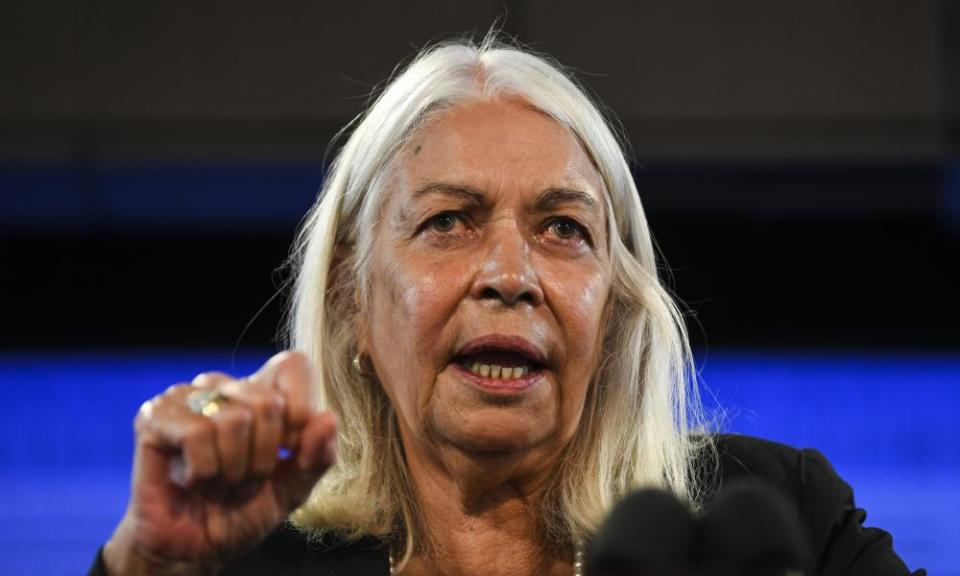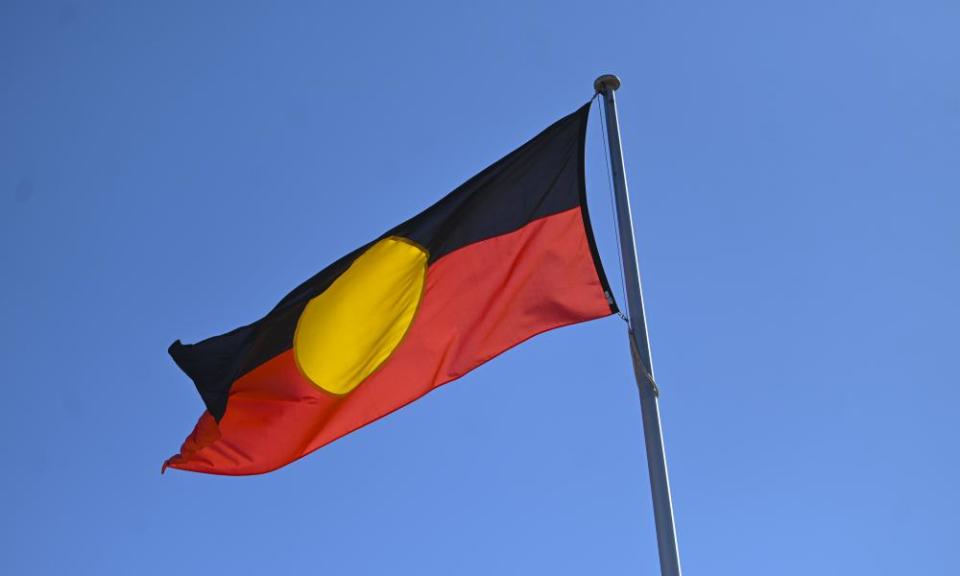Aboriginal flag should be free to use but designer should be compensated, inquiry told

The Aboriginal flag should be owned by the government, but not without compensation to, or the consent of, its original designer, a Senate inquiry has heard.
On Thursday, the Indigenous academic Professor Marcia Langton told the inquiry into the flag’s use that the current commercial restrictions on the flag had “tainted” it, and it should be placed in the hands of an independent, Aboriginal-run body and made free to people and community groups.
However, she said the government should not compulsorily acquire the flag without compensating the original designer, the Indigenous artist Harold Thomas.
“He is a member of the stolen generations and for the government to cause him harm a second time would be unconscionable,” Langton said.
“The only way forward is for him to relinquish all of his rights to the Australian government, and I understand from reading newspapers that minister Ken Wyatt has engaged in negotiations with him to acquire the rights to the flag.”
Related: 'The Aboriginal flag is slowly dying': stoush over use is harming communities, inquiry told
But other witnesses before the inquiry, such as Mick Gooda, said the government should not acquire the flag at all, while former senator Nova Peris said the flag should be compulsorily acquired without compensation to Thomas.
Peris told the inquiry Thomas had already made “hundreds and thousands” of dollars from royalties and had implicitly given the flag to the Aboriginal people of Australia to use for free.
Thomas, a Luritja man, designed the flag in 1971, 24 years before it was made an official flag of Australia, and has retained its copyright since. In November 2018, he granted exclusive use of the flag on clothing, physical and digital media to WAM Clothing, a non-Indigenous owned company, which has since issued infringement notices to the AFL, the NRL and non-profit Aboriginal organisations for using the flag.
On Thursday, Langton said that this commercialisation had “tainted” it as a public symbol, and it ideally should be owned by the government, but that Thomas’s copyright had to be respected.

“His ownership of the rights of the Aboriginal flag has been affirmed by the federal court,” she said. “He used ordinary intellectual property rights that are available to anybody. He has used licences to make a living and provide for his family. How can the government [acquire it] without being unjust to Mr Harold Thomas?
“If [negotiations are] successful, the flag should be under the ownership of a commonwealth body that acts as a trust and would have an Aboriginal board, a small board, say three people, who give approval for its use,” she said.
This trust would only intervene in “extraordinary circumstances” for commercial use, and ordinary people and groups would be free to use the flag, she said.
However, Mick Gooda, a former Aboriginal and Torres Strait Islander social justice commissioner of the Australian Human Rights Commission, disagreed. He said the government should “never” have copyright over the flag, but it should instead go to an Aboriginal community-controlled organisation.
Gooda told the inquiry he was willing to “abandon” the flag as a public symbol, and would not pay a “ransom” for its use.
“I understand and support Mr Thomas’s right to benefit from his intellectual knowledge and contribution,” he said. “While he has a right to do so, I have a right to not use and contribute to some white bloke who is going to benefit from our flag.
“I have sort of abandoned the flag now, and I belong to the Gangulu people of central Queensland, and we are designing our own flag now … This is a personal thing, but I am not at ransom for paying people for that right [to use Thomas’s flag].
“If somebody is going to take ownership, it should not be government. We should be looking for an Aboriginal community-controlled organisation … Step one is consent, and government can be part of the negotiation, but the ownership should be with an Aboriginal or Torres Strait organisation.”
Writer Claire Coleman also told the inquiry that Thomas never wanted the government to acquire the flag, and intended it as “a flag of protest”. She said the government had a poor track record of looking after Indigenous intellectual property, citing the example of Albert Namatjira, where a government trustee sold his copyright for “a pittance” as his family lived in poverty.
When [the flag] was given to us it was free. Now, 49 years later, you are saying we need to pay to use it?
Nova Peris, former senator and Olympian
Coleman said that an elected body of Aboriginal people would need to hold the copyright. For example, the Naidoc committee, or the Indigenous voice to parliament as set out in the Uluru statement.
Former senator and Olympian Nova Peris said the rights to the flag should be compulsorily acquired.
Peris and lawyer Peter Francis told the inquiry they believed Thomas gave express permission and later implicit permission to Aboriginal people to use the flag in 1972 when it was given to Dr Gary Foley in 1972 to fly above a Tent Embassy in Canberra.
She said the flag was different to the example of Namatjira, because his artwork was not flown on flags, printed on uniforms and clothing.
“People have marched under this,” she said. “People have put this flag over their coffins when they have died, they have it as tattoos … When it was given to us it was free. Now, 49 years later, you are saying we need to pay to use it?”
Peris said Thomas should not be compensated by the government because he had already made hundreds of thousands of dollars from the flag, including royalties from MPs and Senators who paid for the right to use the flag.
“Harold Thomas has been paid,” she said. “He has been paid hundreds and thousands of dollars … the Aboriginal flag is a lot more expensive than the Australian flag [to reproduce]. Don’t think Harold Thomas has not been compensated, for 23 years he has been receiving royalties from the world.”
Earlier, Langton also told the inquiry, chaired by Labor’s Malarndirri McCarthy and including Labor’s Patrick Dodson and Greens senator Lidia Thorpe, that while she respected Thomas’s copyright, the flag had gained a broader meaning to Aboriginal people that meant it should be public.
“The flag would not have the meaning it has today solely on the basis of Harold Thomas’s design,” she said. “It has the meaning it has today because of all the Aboriginal people who have used it and flown it – who have used it as a symbol.”
Peris agreed saying: “He gets [money] because Aboriginal people gave the value of that flag to him. He didn’t do it”.
Francis told the inquiry there was a legal argument that there is an implied license for Aboriginal people to use the flag.
Related: Federal government in talks to buy out licences for Aboriginal flag design, Senate hears
“The right to reproduce the flag has already been granted to Aboriginal people, by the force of how the flag was produced in the first place,” he said.
Earlier, Langton said her suggestion was similar to the current ownership of the Torres Strait Islander flag, and that similar legislation had set up other independent government bodies..
She said that if negotiations failed, then regretfully she would recommend that the government hold a competition to design a new, publicly owned Aboriginal flag.
“I think that would be a tragic outcome,” she said. “We should preserve the flag design of Mr Harold Thomas as the Aboriginal flag.”
Under her recommendation, the government would pass legislation to establish the independent Aboriginal trust, and would set out its limits and roles.
“It’s quite normal for flags to be owned by government. And this is an extraordinary and quite strange history that this flag is not owned by government. But nevertheless it is important that the flag is owned by the government, but that there be checks and balances – legislation that sets it out very clearly.
“Compulsory acquisition may be attractive but it doesn’t solve the problem. There must be a total and voluntary relinquishment of his rights to the Australian government.”
Langton also said the government should publish a history of the Aboriginal flag, to explain its complex past and its significance.

 Yahoo Finance
Yahoo Finance 